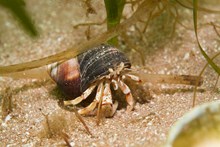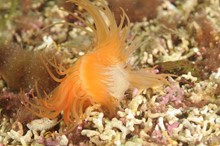08 May, 2018
Gathering names for shellfish
A public consultation on recommended Gaelic names for the most common shellfish in Scotland’s seas has been launched today (8 May) by Scottish Natural Heritage (SNH).
This list of 85 marine mollusc names is largely made up of gastropods and bivalves, along with Gaelic terms for parts of the animals and the different shapes of seashells. The meaning of many of the names are also explained in English.
The recommendations have been produced by a team from SNH and Bòrd na Gàidhlig, led by Gaelic-speaking environmental educator Roddy Maclean.
Some of the names are well-established and familiar to Gaelic speakers. The purpose of the project is to ensure that there is a recommended name for every common species, which can be used in a national context and where Gaelic-speakers do not have access to a tradition-bearer who carries such knowledge. The project is not intended to alter local and dialectal use. Where no known Gaelic name for a species could be found, the team was tasked with proposing one.
Robyn Ireland, SNH’s Gaelic Officer, said: “Our natural heritage and the Gaelic language have an inseparable link. We are committed to encouraging Gaelic speakers and learners to use the language in connection with nature, and hope that this project will help. We welcome the thoughts of anyone with an interest and encourage them to submit their comments to the consultation.”
As part of the project, Roddy Maclean interviewed fourteen elderly Gaelic speakers, mostly from the Western Isles, to obtain guidance on the names they use for marine mollusc species. “There was a general agreement on the names for the most common species,” said Roddy, “but there were some species where people had different terms, or none at all. This challenged us to make a choice and also provide names for species with no recorded Gaelic form.”
It is hoped that this vocabulary will be used by teachers, biologists, naturalists, rangers and parents, along with the wider Gaelic community who wish to discuss the seashore.
The consultation runs from 8 May to 19 June 2018. The proposed list of names can be found at www.nature.scot/gaelic-names-marine-molluscs.
Contact information
- Name
- Carrie Wieteska
- Carrie.Wieteska@nature.scot
NatureScot is Scotland's nature agency. We work to enhance our natural environment in Scotland and inspire everyone to care more about it. Our priority is a nature-rich future for Scotland and an effective response to the climate emergency. For more information, visit our website at www.nature.scot or follow us on X at https://x.com/NatureScot
’S e NatureScot buidheann nàdair na h-Alba. Bidh sinn a’ neartachadh àrainneachd na h-Alba agus a’ brosnachadh dhaoine gu barrachd suim a chur ann an nàdar. Tha e mar phrìomhachas againn gum bi nàdar na h-Alba beairteach agus gun dèilig sinn gu h-èifeachdach le èiginn na gnàth-shìde. Tha an tuilleadh fiosrachaidh aig www.nature.scot no air X aig https://x.com/NatureScot



